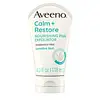What's inside
What's inside
 Key Ingredients
Key Ingredients

 Benefits
Benefits

 Concerns
Concerns

No concerns
 Ingredients Side-by-side
Ingredients Side-by-side

Water
Skin ConditioningHelianthus Annuus Seed Oil
EmollientGlycerin
HumectantGluconolactone
Skin ConditioningGlyceryl Stearate
EmollientPEG-100 Stearate
Sorbitol
HumectantSodium Acrylates Copolymer
Carbomer
Emulsion StabilisingSodium Hydroxide
BufferingAvena Sativa Kernel Oil
Skin ConditioningPEG-40 Hydrogenated Castor Oil
EmulsifyingCaprylyl Glycol
EmollientLecithin
EmollientSodium Citrate
BufferingP-Anisic Acid
MaskingChlorphenesin
AntimicrobialAllantoin
Skin ConditioningWater, Helianthus Annuus Seed Oil, Glycerin, Gluconolactone, Glyceryl Stearate, PEG-100 Stearate, Sorbitol, Sodium Acrylates Copolymer, Carbomer, Sodium Hydroxide, Avena Sativa Kernel Oil, PEG-40 Hydrogenated Castor Oil, Caprylyl Glycol, Lecithin, Sodium Citrate, P-Anisic Acid, Chlorphenesin, Allantoin
Water
Skin ConditioningGlyceryl Stearate
EmollientPolyethylene
AbrasiveHexylene Glycol
EmulsifyingDisodium Cocoamphodiacetate
CleansingDisodium Oleamido Mipa-Sulfosuccinate
CleansingMagnesium Aluminum Silicate
AbsorbentSalicylic Acid
MaskingMenthol
MaskingStearamidoethyl Diethylamine
Oleamide Mipa
Trisodium Sulfosuccinate
BufferingSodium Sulfate
Phenoxyethanol
PreservativeMethylisothiazolinone
PreservativeCI 77891
Cosmetic ColorantEthylhexyl Salicylate
UV AbsorberMethyl Trimethicone
Skin ConditioningHomosalate
Skin ConditioningButylene Glycol
HumectantBenzophenone-3
UV AbsorberButyloctyl Salicylate
Skin ConditioningNeopentyl Glycol Diheptanoate
EmollientButyl Methoxydibenzoylmethane
UV AbsorberButyrospermum Parkii Butter
Skin ConditioningOctocrylene
UV AbsorberPEG-100 Stearate
Silica
AbrasiveDipentaerythrityl Tri-Polyhydroxystearate
EmollientLauryl PEG-9 Polydimethylsiloxyethyl Dimethicone
Skin ConditioningDimethicone
EmollientLaurdimonium Hydroxypropyl Hydrolyzed Soy Protein
Rosmarinus Officinalis Extract
AntimicrobialPerilla Ocymoides Leaf Extract
TonicPlankton Extract
Skin ConditioningCaffeine
Skin ConditioningPotassium Cetyl Phosphate
EmulsifyingSucrose
HumectantStyrene/Acrylates Copolymer
C30-38 Olefin/Isopropyl Maleate/Ma Copolymer
EmulsifyingCetyl Alcohol
EmollientVp/Eicosene Copolymer
Ethylhexylglycerin
Skin ConditioningAmmonium Acryloyldimethyltaurate/Vp Copolymer
PEG-8 Laurate
EmulsifyingSodium Rna
Skin ConditioningLecithin
EmollientPropyl Gallate
AntioxidantArginine Ferulate
Skin ConditioningTocopheryl Acetate
AntioxidantCaprylyl Glycol
EmollientAscorbyl Tocopheryl Maleate
AntioxidantStearic Acid
CleansingXanthan Gum
EmulsifyingNordihydroguaiaretic Acid
AntioxidantDisodium EDTA
Mica
Cosmetic ColorantSodium Dehydroacetate
PreservativeWater, Glyceryl Stearate, Polyethylene, Hexylene Glycol, Disodium Cocoamphodiacetate, Disodium Oleamido Mipa-Sulfosuccinate, Magnesium Aluminum Silicate, Salicylic Acid, Menthol, Stearamidoethyl Diethylamine, Oleamide Mipa, Trisodium Sulfosuccinate, Sodium Sulfate, Phenoxyethanol, Methylisothiazolinone, CI 77891, Ethylhexyl Salicylate, Methyl Trimethicone, Homosalate, Butylene Glycol, Benzophenone-3, Butyloctyl Salicylate, Neopentyl Glycol Diheptanoate, Butyl Methoxydibenzoylmethane, Butyrospermum Parkii Butter, Octocrylene, PEG-100 Stearate, Silica, Dipentaerythrityl Tri-Polyhydroxystearate, Lauryl PEG-9 Polydimethylsiloxyethyl Dimethicone, Dimethicone, Laurdimonium Hydroxypropyl Hydrolyzed Soy Protein, Rosmarinus Officinalis Extract, Perilla Ocymoides Leaf Extract, Plankton Extract, Caffeine, Potassium Cetyl Phosphate, Sucrose, Styrene/Acrylates Copolymer, C30-38 Olefin/Isopropyl Maleate/Ma Copolymer, Cetyl Alcohol, Vp/Eicosene Copolymer, Ethylhexylglycerin, Ammonium Acryloyldimethyltaurate/Vp Copolymer, PEG-8 Laurate, Sodium Rna, Lecithin, Propyl Gallate, Arginine Ferulate, Tocopheryl Acetate, Caprylyl Glycol, Ascorbyl Tocopheryl Maleate, Stearic Acid, Xanthan Gum, Nordihydroguaiaretic Acid, Disodium EDTA, Mica, Sodium Dehydroacetate
 Reviews
Reviews

Ingredients Explained
These ingredients are found in both products.
Ingredients higher up in an ingredient list are typically present in a larger amount.
Caprylyl Glycol is a humectant and emollient, meaning it attracts and preserves moisture.
It is a common ingredient in many products, especially those designed to hydrate skin. The primary benefits are retaining moisture, skin softening, and promoting a healthy skin barrier.
Though Caprylyl Glycol is an alcohol derived from fatty acids, it is not the kind that can dry out skin.
This ingredient is also used as a preservative to extend the life of products. It has slight antimicrobial properties.
Learn more about Caprylyl GlycolGlyceryl Stearate is a mix of glycerin and stearic acid.
It is used to stabilize the mixing of water and oil ingredients. By preventing these ingredients from separating, it can help elongate shelf life. It can also help thicken the product's texture.
As an emollient, it helps soften skin and supports barrier-replenishing ingredients.
In cosmetics, Glyceryl Stearate is often made from vegetable oils or synthetically produced.
This ingredient may not be fungal-acne safe
Fun fact: The human body also creates Glyceryl Stearate naturally.
Learn more about Glyceryl StearateLecithin is a term for a group of substances found in the cell membranes of plants, animals, and humans. They are made up of mixture of phospholipids.
This ingredient has emollient and emulsifying properties.
As an emollient, lecithen helps soften the skin and creates a barrier to keep moisture in.
As an emulsifier, it also helps prevent water and oil ingredients from separating. Lecithin can also help ingredients be better absorbed by the skin.
This is because the phospholipids in lecithin produce liposomes. Liposomes help other ingredients get through the skin barrier.
Depending on the source of this ingredient, lecithin may not be fungal acne safe. This is because some sources of lecithin come from soybean oil, which may feed the malassezia yeast that feeds fungal acne.
We recommend reaching out to the brand you are purchasing from to inquire about the source of their lecithin.
Some other names for this ingredient include soy lecithin and deoiled soy lecithin.
Learn more about LecithinPeg-100 Stearate is an emollient and emulsifier. As an emollient, it helps keep skin soft by trapping moisture in. On the other hand, emulsifiers help prevent oil and water from separating in a product.
PEGS are a hydrophilic polyether compound . There are 100 ethylene oxide monomers in Peg-100 Stearate. Peg-100 Stearate is polyethylene glycol ester of stearic acid.
Water. It's the most common cosmetic ingredient of all. You'll usually see it at the top of ingredient lists, meaning that it makes up the largest part of the product.
So why is it so popular? Water most often acts as a solvent - this means that it helps dissolve other ingredients into the formulation.
You'll also recognize water as that liquid we all need to stay alive. If you see this, drink a glass of water. Stay hydrated!
Learn more about Water